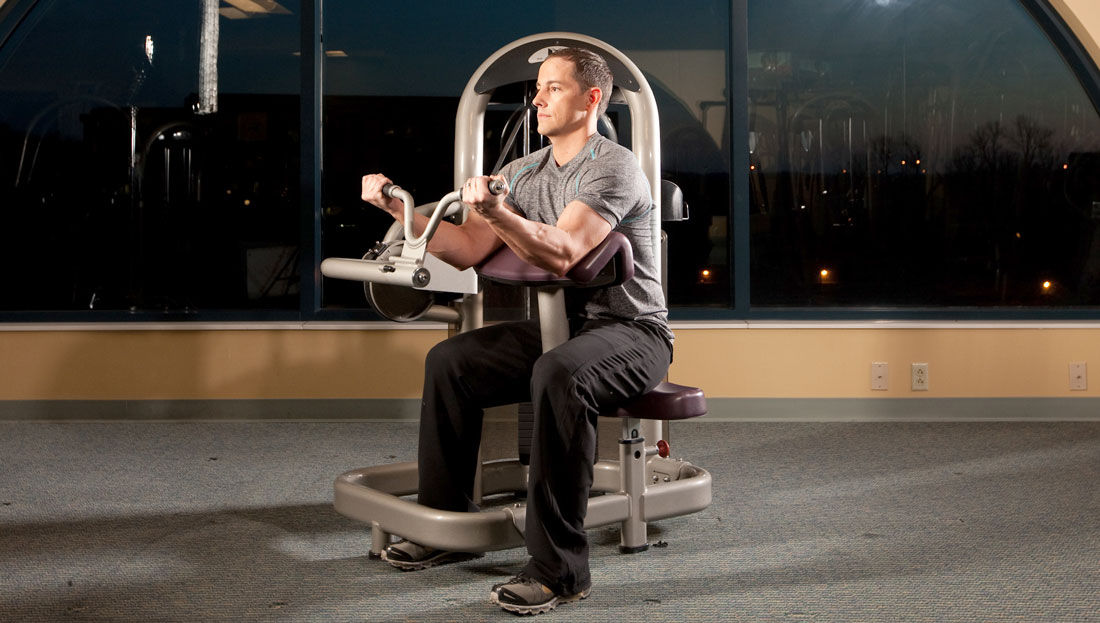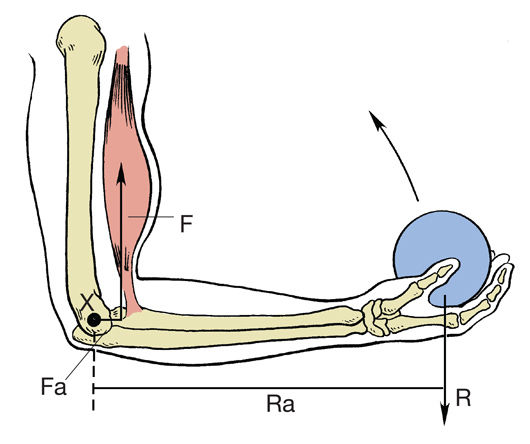
From a weight plate to a vibration platform, almost any piece of exercise equipment can produce benefits when used properly. While almost any type of equipment can help people improve their health, there is one type of workout equipment that is often overlooked by personal trainers because it is perceived as being an outdated relic of a bygone era, but, if used correctly, it is virtually guaranteed to deliver results: resistance-training machines.
Making the Case for Resistance-training Machines
Clients offer numerous reasons for wanting to start an exercise program, but one of the most oft-cited is a desire to change their appearance. Explosive lifts with barbells, kettlebells and heavy medicine balls can help enhance muscle-force output, burn calories for weight loss, and strengthen elastic connective tissues, yet these types of workouts may not be optimally suited for stimulating the muscular development that many clients want. There are distinct differences among exercise programs designed to improve mobility, burn calories, enhance aerobic efficiency or maximize muscle growth.
When it comes to adding more muscle or enhancing the appearance of existing muscles, resistance-training machines are among the most effective tools available. One of the primary mechanisms of muscle growth is mechanical overload, which is the actual physical force placed on muscle tissue by an external resistance. Along with ease of use, this is an important reason for incorporating strength-training machines into your clients’ programs.
Ease of Instruction
For a beginning exerciser, a kettlebell, while a great tool, looks more like a cartoon bomb from an old episode of Rocky and Bullwinkle than something to be used for strength training. Walking into a gym is challenging enough, and having to figure out which equipment to use and how to use it could be the barrier that keeps someone from coming back. Additionally, many new exercisers lack the foundational strength or even the proper posture to make free-weight training a viable option.
Once they are properly set up and aligned for an individual’s body, machines provide a safe and effective option for even the newest or least-conditioned clients to achieve the benefits of resistance training. In fact, that’s why machines were developed in the first place—to help increase the benefits of resistance training while reducing the risk of injury that could occur as the result of improper form or technique.
All Weight is Not the Same
Any time a muscle contracts to create motion, it initiates torque in the human body. Torque is a force that creates rotation or a “turning effect.” The distance between the location of the weight and the axis of rotation is the moment arm. As muscles contract to move a weight, they generate the force to create a curvilinear motion at a joint (McGinnis, 2005).
Gravity is an external, ever-present force acting on muscles when using free weights. However, when using free weights, the weight load itself is not always consistent throughout the movement. Muscles generate the torque to create joint movement; when the joint angle changes, the position of the weight relative to gravity also changes. This, in turn, creates different levels of force that the muscle must overcome to move the weight (McGinnis, 2005).

Example of a lever system in the human body
Note: X = axis of rotation; F (biceps contraction) = motive force; R (weight in hand) = resistance; Fa (biceps force x distance of biceps attachment from axis) = lever arm of the motive force; Ra (weight x distance from axis) = lever arm of the resistance.
Consider the example of a biceps curl. With the arm fully extended, as the biceps contract to flex the elbow there is a tremendous amount of torque created because of the location of the attachment of the biceps relative to the axis of rotation of the elbow. The moment arm is the distance between the axis of rotation at the elbow and the location of the weight in the hand. Once the elbow reaches 90 degrees of flexion, the moment arm is horizontal to gravity. This is the greatest amount of torque that will be produced because as the biceps continue to shorten and the location of the weight (in the hand) moves closer to the fulcrum of the elbow, it ultimately reduces the tension applied to the muscle (McGinnis, 2005). The end result is that certain parts of the movement engage the biceps to generate a tremendous amount of force, while other parts require a minimum amount of involvement from the biceps. Using pulleys and levers, machines create constant forces that are applied to the involved muscles throughout the entire range of motion (ROM) of the exercise, versus the varied amount of muscular force used in free-weight exercises.
Mechanotransduction is the technical term that describes how mechanical forces create the chemical reactions that lead to muscle growth. In the case of human muscle tissue, forces applied from external resistance damages actin-myosin protein filaments which, in turn, initiates the biochemical reactions responsible for repairing the muscle tissue as well as producing new muscle proteins. As researchers have observed, “Mechanical tension may be the most important factor in training-induced muscle hypertrophy. Mechanosensors are sensitive to both the magnitude and duration of loading and these stimuli can directly mediate the intracellular signaling to bring about hypertrophic adaptations” (Schoenfeld, 2016).
Time Under Tension is the Key to Muscle Growth
Here’s an important reminder: Strength training alone does not induce muscle growth. A training load has to cause fatigue to stimulate the physiological mechanisms responsible for changing the function and appearance of muscle. Time under tension (TUT) is the length of a time that an external force is applied to the contractile element of muscle (the individual fibers) over the course of an entire set of repetitions. According to Brad Schoenfeld, author of Science and Development of Muscular Hypertrophy, “Mechanical tension is the primary driving force in the hypertrophic response to regimented resistance training…suggesting that TUT is an important parameter for hypertrophic adaptations” (Schoenfeld, 2016).
Understanding how muscles respond to TUT can help you determine the best way to train a client for maximal muscle growth. Lifting a weight for a high number of repetitions could be considered an exercise in futility (rather than for muscle growth) if tension doesn’t remain constant throughout each repetition and the reps are not performed to fatigue. One of the most important benefits of using a strength-training machine is that tension is constant through the ROM, which can help promote muscle growth or enhance muscle definition. Performing reps to a point of momentary fatigue (the inability to perform another rep) on a machine places a mechanical overload on the muscle fibers, which is necessary for stimulating growth.
Different Types of Machines
Manufacturers have developed different types of resistance-training machines that can be used for different purposes. “The design goal of some exercise machines on the market is to provide a constant resistance torque throughout the range of motion of the exercise,” explains Peter Merton McGinnis, author of Biomechanics of Sport and Exercise. “Other machines are designed to provide a resistance torque that varies in proportion to the changes in the moment arm of the muscle being exercised as the exercise is performed. In these machines, the design goal is to have the muscle produce a constant force throughout the range of motion of the exercise” (McGinnis, 2005).
Vladimir Verkhoshansky and Mel Siff, authors of Supertraining, identify two primary types of resistance-training machines:
Functional Resistance Machines: The purpose of these machines is to offer resistance in sport-specific patterns. Examples include cable pulley machines, as they help maintain a constant force on the muscles, while the single axis of rotation at the pulley allows for an extensive variety of movement options. Cable pulley machines allow multiple movements, making them an ideal option for reinforcing muscle-force production in a variety of patterns used for sport performance or activities of daily living.
Non-functional Resistance Machines: The sole purpose of these machines is to offer general resistance in non-sport-specific movement patterns. Examples include machines that isolate a single joint or place the entire load into a specific muscle group. “The important limitation of many strength-training machines is that they are designed to train muscles, not movement. Because of this, they are not the most important training tool for athletes” (Verkhoshansky and Siff, 2009).
A Revolution is Born
When he introduced NautilusTM machines in 1970, fitness industry pioneer Arthur Jones revolutionized strength training with the introduction of the cam. Jones understood the role of TUT in muscle growth and observed that free weights do not provide the necessary stimulus to achieve the levels of growth desired by bodybuilders. For these reasons, he created a system that keeps direct tension on the muscle throughout the entire exercise. Many machines use pulleys and levers in an attempt to keep a muscle under tension for the entire ROM. Jones, however, used a cam with a shape similar to a nautilus sea shell (hence the name of the company) that allows the mechanical tension loaded into the muscle to change as the joint angle changes during the exercise.
“The Nautilus cam varies torque (rotational force) about a rotational axis… [As] the radius of the cam changes [it is] timed to the positional strength of the working body part,” wrote Ellington Darden in The Nautilus Book (1990). In other words, as the body part becomes stronger (through the range of motion), the cam radius increases; thus the effective lever increases, providing increased torque or effective resistance.
A cable-and-pulley machine is different than free weights in that the cable can keep a constant tension on the muscle. However, like free weights, as joints move and the angles change, the amount of force required by the involved muscles will change as well. Conversely, a cam has an irregular shape that keeps the amount of resistance constant through the entire exercise. One is not necessarily better than the other, so the choice of which to use comes down to the stated goals of the client:
- If a client wants to burn calories to achieve or maintain a healthy weight, cable machines that engage multiple muscles and allow a variety of movement patterns could be a better option.
- If a client wants to increase muscle size or definition, it makes sense to incorporate the use of some body part–specific machines into his or her program.
Table 1 provides a review of additional benefits of using strength-training machines.
Table 1. Additional Benefits of Strength-training Machines
| |
|
Benefit
|
Description
|
|
Controlling the path of motion for the application of mechanical overload
|
Mechanical overload is the amount of physical force placed on a muscle and is essential for stimulating muscle growth (Schoenfeld, 2016). Compound barbell lifts require optimal range of motion from a number of joints. If one of those joints does not function properly, it could cause an injury. Being able to control the path of motion and place the greatest amount of force where a muscle is the strongest can be a safe way to apply the overload necessary to stimulate muscle growth.
|
|
Creating metabolic overload
|
Metabolic overload occurs when a muscle works to a point of momentary fatigue and does not have the energy to generate another contraction. Muscle growth occurs either as a result of mechanical or metabolic overload (Schoenfeld, 2016). A long-time body-building secret for achieving rapid muscle growth is through the use of drop sets, which require doing an exercise to the point of momentary fatigue, immediately lowering (dropping) the weight and continuing to the next point of exhaustion. Machines provide the safest and most time-efficient means of being able to perform drop sets to the point of complete fatigue, which ensures that all fibers in a particular muscle have been engaged.
|
|
Offering a time-efficient solution for circuit training
|
Circuit training requires transitioning from one exercise to another with a minimal amount of rest and can be effective for creating both a mechanical and metabolic overload for your clients.
|
|
Placing resistance specifically on the contractile element of muscle
|
There are two basic structural components of muscle: (1) the elastic component of fascia and connective tissue responsible for providing shape and transmitting forces from one section of muscle to another; and (2) the contractile element of the actin and myosin protein filaments responsible for controlling muscle contractions. Improving muscle size and strength requires using external resistance to stimulate the contractile element to become capable of generating higher levels of force. Machine training can be extremely effective at achieving this outcome (Siff and Verkhoshansky, 2009).
|
|
Strengthening bones as well as muscles
|
The mechanical forces that result in muscles becoming stronger also help to increase bone mineral density, leading to stronger bones that are more resistant to injury in the event of a fall.
|
The Case Against the Use of Machines
Resistance machines deliver results because they target individual muscles, but they do have certain limitations. For example, they may not the best tool for helping to improve balance, coordination or overall movement efficiency. Balance and movement training are different skills compared to resistance training; an exercise program to enhance balance or coordination may help improve the nervous system’s ability to engage certain muscles to improve body control but will not apply enough load for significant improvements in muscular development.
Dynamic balance is the ability to control the body’s shifting center of mass over its changing base of support. Because most machines require users to sit or lie down, they do not engage the vestibular system responsible for helping maintain balance when standing in an upright position.
Additionally, machines provide a stable environment for isolating individual joint actions, so they may not be the most effective option for individuals who need helping developing the body awareness and neural control to move efficiently through gravity. “The foundational patterns of movement require integration between joint stability and mobility, and because most use only one joint at a time, resistance-training machines create a false environment that do not allow this integration to occur,” explains Sam Berry, MS, an ACE Certified Personal Trainer and Master Trainer.
Adding Machines to Workout Programs
One approach to programming is to use machines to develop the strength required to learn more complex movement patterns. This is how Mike Pepi, a personal trainer at the Equinox Sports Club in Washington, D.C., uses machines with his some of his clients. “It may not be the right time to introduce a compound movement, so I’ll use a machine to help strengthen individual muscles first,” explains Pepi. “That way I help strengthen individual links before integrating the entire kinetic chain. In addition, many of my older adults have a hard time gripping free weights, but machines allow me to use heavier loads safely because I don’t need to worry about grip strength as a client is pushing or pulling a lever.”
Pepi notes one drawback to using machines with certain clients. The machines, he says, “are designed for the average individual, so some of my more petite or larger clients just don’t fit into them comfortably.” Megan Madden Rodham, a former member of the U.S. National Women’s Rugby Team player pool agrees. “I never feel like they fit right for my size no matter how much I adjust.”
Smart program design means knowing how to alternate the types of equipment and amounts of intensity. Another way to use machines is to enhance load in specific muscles after a compound movement pattern. For example, have your client perform a multijoint exercise, such as a barbell squat, followed immediately by a muscle-isolation exercise such as a machine-based hamstrings curl to continue using a specific muscle to the point of fatigue, thus creating the catalyst for muscle growth.
Consider this as one possible application for machines: When working with clients, you’re helping them to improve their mobility and stability and, ultimately, to move better, yet they still need the resistance training required for muscle growth. Give them both. During sessions, coach the foundational patterns of movement and then challenge clients with integrated movement pattern-based exercises. On the days you are not training your client, encourage him or her to do the machine circuit at your club. This increases the client’s self-efficacy while also enhancing muscle growth—clearly a win-win.
Teaching clients how to safely set up and perform a resistance-training circuit on machines allows them to perform a strength workout even when you’re not there for coaching and feedback. When a client doesn’t have much time for a workout, he or she could go through the circuit two or three times and receive the benefits of circuit training without needing to know how to properly organize, set up and use advanced equipment.
“I like to use minimal equipment and teach my clients how to move functionally with free weights and other equipment like the TRX,” says Carlie Scharing, a personal trainer in Oceanside, Calif. “However, I show them the ins and outs of how to use machines so they can navigate the gym floor and get a great workout even when I’m not there to help.”
Erin Carson, a personal trainer and co-owner of Rally Sport, a gym in Boulder, Colo., also uses machines in his clients’ program design. “I love machines. When clients show fatigue, I like to give their nervous systems a little recovery by putting them on a machine,” he explains. “It allows them to keep using their muscles while reducing the overall stress load on the body.”
Conclusion
Don’t get stuck in the trap of training your clients the same way you train yourself. You can design the best program in the world, but if the client doesn’t feel comfortable doing it when you’re not there to coach and correct, you’re doing your client a major disservice. While you may like using barbells and kettlebells for your personal workouts, keep in mind that many, if not most, of your clients may be more comfortable using resistance-training machines than free weights when it comes to exercising on their own time.
Additionally, because they are relatively easy to learn how to use, machines can help clients become stronger while establishing the healthy behaviors necessary to make exercise a consistent part of their weekly routine. Ultimately, the goals of an individual client should determine the tools and methods used to achieve those goals. For those clients who are new to exercise or with specific muscular development goals, machines can become an important resource for the exercise programs that you design.
References
Darden, E. (1990). The Nautilus Book (5th ed.). Chicago, Ill.: Contemporary Books.
McGinnis, P.M. (2005). Biomechanics of Sport and Exercise (2nd ed.). Champaign, Ill.: Human Kinetics.
Schoenfeld, B. (2016). Science and Development of Muscular Hypertrophy. Champaign, Ill.: Human Kinetics.
Verkoshansky, Y. and Siff, M. (2009). Supertraining (6th ed.). Rome, Italy: Verkoshansky.com.

 by
by 



